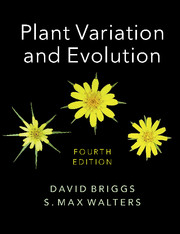Book contents
- Frontmatter
- Contents
- Preface to the Fourth Edition
- Acknowledgements
- Note on names of plants
- List of abbreviations
- 1 Investigating plant variation and evolution
- 2 From Ray to Darwin
- 3 Early work on biometry
- 4 Early work on the basis of individual variation
- 5 Post-Darwinian ideas about evolution
- 6 DNA: towards an understanding of heredity and molecular evolution
- 7 Breeding systems
- 8 Intraspecific variation and the ecotype concept
- 9 Pattern and process in plant populations
- 10 Pattern and process: factors interacting with natural selection
- 11 Populations: origins and extinctions
- 12 Species and speciation: concepts and models
- 13 Allopatric speciation and hybridisation
- 14 Abrupt speciation
- 15 The species concept
- 16 Flowering plant evolution: advances, challenges and prospects
- 17 Historical biogeography
- 18 The evolutionary impact of human activities
- 19 The taxonomic challenge ahead
- 20 Conservation: from protection to restoration and beyond
- Glossary
- References
- Index
15 - The species concept
Published online by Cambridge University Press: 05 June 2016
- Frontmatter
- Contents
- Preface to the Fourth Edition
- Acknowledgements
- Note on names of plants
- List of abbreviations
- 1 Investigating plant variation and evolution
- 2 From Ray to Darwin
- 3 Early work on biometry
- 4 Early work on the basis of individual variation
- 5 Post-Darwinian ideas about evolution
- 6 DNA: towards an understanding of heredity and molecular evolution
- 7 Breeding systems
- 8 Intraspecific variation and the ecotype concept
- 9 Pattern and process in plant populations
- 10 Pattern and process: factors interacting with natural selection
- 11 Populations: origins and extinctions
- 12 Species and speciation: concepts and models
- 13 Allopatric speciation and hybridisation
- 14 Abrupt speciation
- 15 The species concept
- 16 Flowering plant evolution: advances, challenges and prospects
- 17 Historical biogeography
- 18 The evolutionary impact of human activities
- 19 The taxonomic challenge ahead
- 20 Conservation: from protection to restoration and beyond
- Glossary
- References
- Index
Summary
The ‘species concept’ in biology, as we saw in Chapter 2, has engaged the attention of most of the famous naturalists in earlier centuries, from Ray through Linnaeus to Darwin himself, and debate, argument and controversy continues to the present day (see Rieseberg, Wood & Baack, 2006; Wilkins, 2009; Mischler, 2010; Kunz, 2012).
Species as part of natural classifications
Kinds of organisms can be arranged in a hierarchy, each higher group containing one or more members of a lower group. A study of primitive biological classifications reveals that hierarchical classifications are a widespread feature of languages in general, and the particular hierarchy of genus and species, which modern biology uses, is really only a special case of a general linguistic phenomenon. The inescapable conclusion from such comparative studies is that hierarchical taxonomic classifications arise in human societies wherever they develop, and that the detail of the treatment found in folk taxonomies reflects the importance of the organisms concerned in the life of the particular tribe or culture. This view of taxonomy as the product of the human need to understand, describe and use the plants and animals applies to the Latin biological classification we use today.
Although we talk of associating species into genera and genera into families, that is not what happened in the early days of biological classification. It is indeed arguable that the idea of a kind of plant or animal envisaged by the ordinary person corresponds, in the history of classification, more closely to the modern genus than it does to species. It was these classical and medieval ideas of ‘kinds’ of plants that were available in the eighteenth century to Linnaeus, who stabilised the scientific names in the binomial form in which we still use them. So the Linnaean names (e.g. Quercus = Oak and Fraxinus = Ash) indicate the level of recognition of ‘kinds’ in the botany of medieval Europe. This is beautifully illustrated by the Carrot family (Apiaceae/Umbelliferae), many of which were familiar plants in classical times in Europe, mainly because they were cultivated for food or flavouring (e.g. Daucus = Carrot, Pastinaca = Parsnip) or because they were poisonous (e.g. Conium = Hemlock). All these familiar European plants were accurately described and given what later became their generic names, long before Linnaeus.
- Type
- Chapter
- Information
- Plant Variation and Evolution , pp. 331 - 335Publisher: Cambridge University PressPrint publication year: 2016

